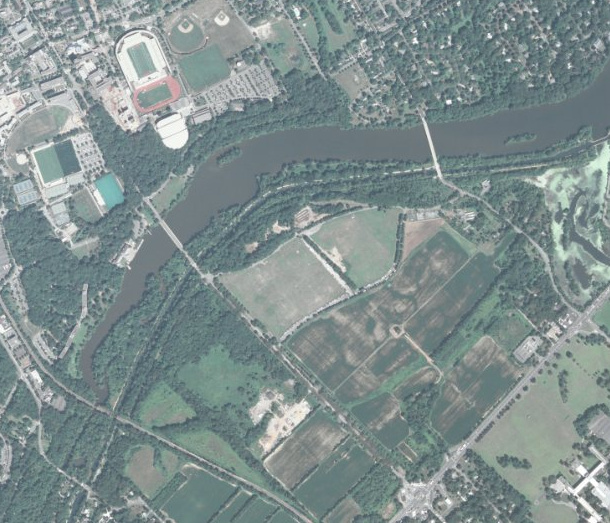Solar Power at Princeton University
February 25, 2011
Princeton University has announced plans to build a 5.3-
megawatt solar farm on 27
acres (11
hectares) of land it owns in
West Windsor Township, just south of its main Princeton campus.[1-3] Construction of the system, which is planned to have 16,500
photovoltaic panels, is expected to begin as early as this summer. Completion is expected after a year's construction, pending speedy approvals from local and state authorities. The useful lifetime of this solar farm is expected to be at least 30 years.[2] As large as this installation might appear, its generating capacity of eight million
kilowatt-hours per year, about the power requirement for 7,000
residential households, is just 5.5 percent of the university's electrical requirement.
The project site, as shown in the
satellite image below, is between a
railroad spur line, the
Delaware and Raritan Canal, Washington Road and
US Route 1. Every effort will be made to hide the solar farm from view, with a row of trees along Washington Road, and other landscaping along the canal towpath.[1] As a final touch, a mix of native
meadow grasses that do not need to be mowed will be planted under the panels.[1]

Satellite image of Princeton University solar site at -74° 38' 20" 40° 20' 13". The proposed site is in the fields at the center of the image. (USGS Image).
Princeton has set a goal of reducing its
carbon dioxide emission to the level it had in 1990 (95,000
metric tons), by 2020. Princeton reduced its emissions 2.5 percent in the last two years, primarily through use of a central
cogeneration plant. This plant provides steam heat to campus buildings, chilled water for air conditioning, and 15 megawatts of electricity - enough to power about half the campus.[1]
This solar farm isn't the university's first venture into solar energy. There's a small, 216 panel array on the
Frick Chemistry Laboratory. In 2009, a 5,000 solar module array was installed on the roof of the
Research Collections and Preservation Consortium, an archival storage facility jointly owned and operated by
The New York Public Library,
Columbia University and Princeton University, as can be seen in the following satellite image. This building is not on the main Princeton campus, but at the
Princeton Forrestal Center a few miles to the north.
View Larger Map
The solar panels will be mounted on 4-5 foot poles and will face south. In order to take full advantage of the
insolation, about 80% of the panels will be
sun-tracking, and the remaining 20% will have a fixed 25 degree tilt.[1] This mix was necessitated by the irregular perimeter of the site. A transmission line installed under the Delaware and Raritan Canal and
Lake Carnegie will feed the power to the university campus.
Of course, every big money project of this type has an interesting financial subtext. The solar farm won't be owned by Princeton University.
Key Equipment Finance of
Superior, Colorado will build it and lease it to Princeton. The solar farm owner, through the
American Recovery and Reinvestment Act (ARRA), gets a federal grant and special
depreciation treatment. There are also benefits under
New Jersey's Solar Renewable Energy Certificate (SREC) program.[1] In the New Jersey program, authorized through 2020, a solar energy generator gets a certificate for every 1,000 kilowatt-hours of solar energy it generates, and it can sell these certificates for cash to electrical suppliers in the state.[2]
Princeton University will provide real-time data of the solar installation performance to researchers at the university.[2] These data, plus the presence of the solar installation, will generate awareness of solar energy among students and faculty.
Ilhan Aksay, a professor of
chemical and
biological engineering who works on flexible
solar cells, had this to say about the project.[2]
"From my experience, the main benefit of the project will be the awareness of the importance of this topic in the minds of students... The fact that Princeton University took a lead in this sends out a signal that Princeton is serious about this. I expect that more students will now be interested in pursuing related research, and this will affect the faculty as well."
The Princeton model can be applied to almost every "
college town." A college in a small town is a major user of electricity, and its use is concentrated in a small area that's typically surrounded by nearby undeveloped, or underdeveloped, land area. College administrators, pull out your local maps and check out your options!
References:
- Ruth Stevens, "Princeton to install powerful solar collector field," Princeton University Press Release, February 2, 2011.
- Jason Jung, "University plans solar panel field," Daily Princetonian, February 4, 2011.
- 5.3 MW Solar Farm For Princeton University, Energy Matters.
Permanent Link to this article
Linked Keywords: Princeton University; megawatt; solar farm; acre; hectare; West Windsor Township; photovoltaic panels; kilowatt-hour; residential household; satellite image; branch line; railroad spur line; Delaware and Raritan Canal; US Route 1; meadow grass; -74° 38' 20" 40° 20' 13"; United States Geological Survey; USGS; carbon dioxide; metric ton; cogeneration; Frick Chemistry Laboratory; Research Collections and Preservation Consortium; The New York Public Library; Columbia University; Princeton Forrestal Center; 40.344692, -74.614672; insolation; sun-tracking; Lake Carnegie; Key Equipment Finance; Superior, Colorado; American Recovery and Reinvestment Act; ARRA; depreciation; New Jersey's Solar Renewable Energy Certificate (SREC) program; Ilhan Aksay; chemical engineering; biological engineering; solar cells; college town.